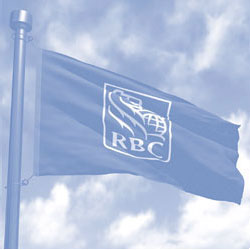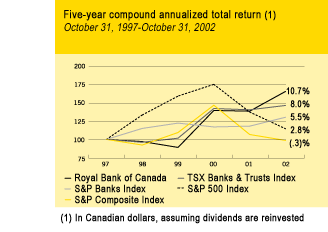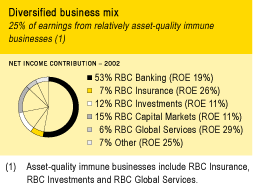
| Group Management Committee |
| Peter
W. Currie Vice-Chairman & Chief Financial Officer |
| Suzanne
B. Labarge Vice-Chairman & Chief Risk Officer |
| Martin
J. Lippert Vice-Chairman RBC Global Services & Chief Information Officer |
| W.
Reay Mackay Vice-Chairman RBC Investments |
| James
T. Rager Vice-Chairman RBC Banking |
| Irving
Weiser Chairman & CEO RBC Dain Rauscher |
| W.
James Westlake Chairman & CEO RBC Insurance |
| Charles
M. Winograd Vice-Chairman RBC Capital Markets |
PRESIDENT &
CHIEF EXECUTIVE OFFICER
economic growth, financial market uncertainty and geopolitical tensions, we generated record net income for our shareholders this past year totalling $2.9 billion. While adjusting our businesses to perform well in the short term, we also continued to expand our capabilities and position ourselves for sustained long-term growth and consistent performance.
We have a number of strengths that we continued to build upon this year. Our diversification by business and geography tends to stabilize our returns and reduce earnings volatility. In Canada, we also have leading positions in most businesses, a large base of about 10 million clients and a very strong brand. This gives us the opportunity to deepen relationships with our existing clients and expand our business with them by offering a full suite of competitive products and services. In addition, we have a disciplined growth strategy. We have created a solid foundation in the United States, comprising personal and commercial banking, full-service brokerage, insurance and equity capital markets operations, and these businesses collaborated further with each other and with their Canadian partners this year to enhance the client experience, grow the business and realize efficiencies. We also have a record of solid and consistent financial performance and shareholder value creation. Shareholders have benefited not only from our share price appreciation, but also from our long history of uninterrupted and rising dividend payments.
Our goals
Our three key goals are to be recognized as the undisputed lead provider of integrated financial services in Canada, a best in class provider of select financial services in the U.S. and a premier provider of specialized global financial services. In Canada, we are committed to retaining our strong positions in all our businesses and offering our services on an integrated basis so we can provide better service and value to our clients. In the U.S., we want to focus on growing select areas, such as personal and commercial banking and wealth management, where we believe we have a competitive advantage and can offer best in class services. Outside North America, we will continue to focus on those businesses, such as global private banking, custody and foreign exchange, where we are strong globally and can generate attractive returns.
Our vision, goals, strategic priorities and values are shown in the corporate profile at the beginning of this report. It is against these that we base our decisions and measure our performance, both individually and collectively.
Our strategic priorities
To achieve our goals, we have established four key priorities – strong fundamentals, North American expansion, growth of high-return or high-P/E multiple businesses, and cross-platform leverage.
Strong fundamentals
In 2002, we
generated record net income of $2.9 billion, up 19 per cent from 2001. Excluding
special items and the amortization of goodwill last year, net income was up 17
per cent and earnings per share were 13 per cent higher.
Our aim is to maintain financial performance in the top quartile of North American financial companies and to meet or exceed our own objectives. As shown on page 8, we performed strongly this past year compared to almost all of our objectives – growing both revenues and earnings per share at a double-digit pace, continuing to demonstrate cost and asset quality discipline, enhancing our capital ratios and maintaining top quartile valuation. Our common share price rose 16 per cent in 2002, compared to a return of 1 per cent for the TSX Banks & Trusts Index over that same period.
Our objectives for 2003 are similar to those we strived for in 2002, with the exception of the revenue growth goal, which we have lowered to 5–8 per cent from last year’s 7–10 per cent, which had included a full year of revenues for RBC Centura, acquired seven months into 2001. In addition, we have raised the earnings per share growth objective to 10–15 per cent, reflecting our aim of increasing revenues at a faster rate than expenses and our expectation that capital market activity will pick up somewhat in 2003.
We have also modified some of our medium-term goals. With our strong commitment to shareholder value, we have raised our dividend payout goal from 30–40 per cent to 35–45 per cent. Our payout ratio this past year was 37 per cent and we raised our common share dividends by 10 per cent during the year. We also increased our Tier 1 capital ratio goal to 8–8.5 per cent from 8 per cent. Finally, we are raising our specific provision for credit losses ratio goal to .35–.45 per cent from .30–.40 per cent, in recognition of continuing economic uncertainty and expected growth in the personal, credit card and small business loan portfolios, which have loss ratios above the earlier goal range.

North
American expansion
One of our important objectives for 2002 was to enhance
the performance of our recent U.S. acquisitions. These acquisitions contributed
21 per cent of total revenues in 2002, up from 12 per cent a year ago, and generated
net income of $232 million, up from $(23) million on a core basis last year. This
reflects the cessation of goodwill amortization expense this year, a full year
of results and stronger performance at RBC Centura, the benefits of integrating
Tucker Anthony Sutro Corporation into RBC Dain Rauscher and strong results from
RBC Dain Rauscher’s fixed income operations. RBC Dain Rauscher generated
profit of $3 million in 2002 versus a loss of $73 million in 2001. Its retention
compensation expenses will fall in 2003, further aiding performance.
We also aimed to limit U.S. acquisitions to a total purchase price of $1 billion in 2002, in order to focus our efforts on integrating and leveraging our earlier acquisitions. We succeeded, announcing four small acquisitions for US$610 million. Two are in personal and commercial banking (Eagle Bancshares, Inc. and Admiralty Bancorp, Inc.) and these will allow us to develop a presence in the high-growth Atlanta and Florida markets with a small number of well-located branches, a client base, banking licenses and good management. The Admiralty Bancorp acquisition is expected to close in early 2003. We intend to complement these small acquisitions with new branch expansion in high-growth regions in the southeastern U.S.
Each of our acquired U.S. companies is attempting to grow revenues and enhance efficiency not only on its own but also by working closely with the Canadian operations of its own platform and with its sister divisions in the U.S. As an example, RBC Liberty Insurance has launched a life specialist initiative, a referral sales operation targeting clients of RBC Centura with 19 insurance specialists operating in North Carolina banking centres.
We are on our way to establishing a focused growth platform in the U.S., and detailed discussion of our North American expansion efforts is provided on pages 9–12.
Growth of high-return
or high-P/E multiple businesses
We are focused on growing those businesses
that have high returns, good growth prospects and attractive P/E multiples. Two
areas we have targeted for the greatest long-term expansion are RBC Banking and
RBC Investments, although other segments also have priority areas they are expanding.
RBC Banking generates solid, consistent returns and we believe we can apply the
principles which have supported our success in Canada, including our strong customer
relationship management (CRM) capabilities, to the U.S. market. While the performance
of RBC Investments has been dampened by the weakness in capital markets and client
trading activity, the returns of this business in normal market conditions are
strong and we are confident the long-term prospects for this business are good
given demographic shifts and significant expected intergenerational wealth transfer.
As we have expanded our high-return businesses, we have continued to shrink low-return, capital-intensive and relatively volatile operations such as corporate lending. This contributed to a $5.1 billion reduction in total business and government loans this past year. We have reduced risk-adjusted assets in our corporate loan book by approximately 30 per cent since 1998 and plan on further reductions.
The benefits of our diversification, by business and geography, were apparent again in 2002. Close to 40 per cent of our core earnings growth this past year came from our recent U.S. acquisitions, demonstrating the benefit of geographic diversification. Also, despite continued economic uncertainty and weakness in capital markets, four of our five business platforms recorded double-digit core earnings growth. One-quarter of our earnings this year came from the relatively asset-quality immune businesses of RBC Insurance, RBC Investments and RBC Global Services.
Steps the business segments took this year to grow their operations are discussed on pages 13–15, while a detailed review of their financial performance and strategies is provided on pages 26–37.

Cross-platform
leverage
This new strategic priority involves working across our various
businesses and functions to share best practices, grow revenues by offering the
products and services of one segment to the clients of another, and enhance efficiency
by eliminating duplication. We have five very strong business segments and a large
client base. By working together and offering integrated services to our clients,
we believe we have a tremendous opportunity to grow our business and operate more
efficiently. There are a number of initiatives underway across the organization
that are focused on this priority, including the launch of RBC Referrals to better
serve our clients and generate more business opportunities within RBC.
A detailed discussion of cross-platform leverage is provided on pages 16–17.
Commitment to our shareholders
While we have a record of significant shareholder value creation, we are by no means complacent. We will continue to target superior profitability and returns for our shareholders by continuing to pursue strategies and initiatives to grow our businesses profitably, manage our costs and risks effectively, and deploy our capital efficiently – reinvesting in our businesses and growth markets, and returning the excess to shareholders through share repurchases when appropriate as well as through dividend payments. The increase in our medium-term dividend payout goal attests to our commitment to rewarding shareholders.
Corporate governance
This past year was marked by events in the corporate sector that led investors to seriously scrutinize the oversight and governance of companies. We have always attempted to be a leader in corporate governance and we will continue to strive for the highest standards in this area. We also made a number of refinements to our governance policies this past year, including changes relating to senior management and director compensation that took effect on November 1, 2002. We have also invested significant resources to ensure that our compliance and internal audit standards, policies and procedures represent best practices and that all parts of our organization live up to our values.
In addition to the comments from our Chairman on page 2, a discussion of corporate governance and board committee mandates and activities is provided on pages 106–107 and in our management proxy circular dated January 3, 2003, which includes details of senior management and director compensation.
Our employees
The strong results we recorded this past year reflect the tremendous dedication, commitment and hard work of our employees throughout RBC. Our people are our core strength. In 2002, we articulated five values key to RBC, shown in our corporate profile at the beginning of this report. These are embedded in the annual performance appraisal process for all our employees and will further inspire our people to provide excellent service and work together in a spirit of co-operation and trust for the benefit of our clients and shareholders.

Gordon
M. Nixon
President & Chief Executive Officer
December 10, 2002